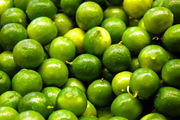Lime (fruit)

| Nutritional value per 100 g (3.5 oz) | |
|---|---|
| Energy | 126 kJ (30 kcal) |
| Carbohydrates | 11 g |
| Sugars | 1.7 g |
| Dietary fiber | 3 g |
| Fat | 0.2 g |
| Protein | 0.7 g |
| Water | 88 g |
| Vitamin C | 29 mg (48%) |
| Percentages are relative to US recommendations for adults. Source: USDA Nutrient database |
|
Lime is a term referring to a number of different fruits, both species and hybrids, citruses, which are typically round, green to yellow in color, 3–6 cm in diameter, and containing sour and acidic pulp. Limes are often used to accent the flavours of foods and beverages. These are also known as Kagzi Lime in North, North East and Central India. Some varieties are also known as scented lime. These have more scent than other common lime varieties. They are usually smaller than lemons, and a source of vitamin C. Limes are grown all year round and are usually sweeter than lemons.
Limes are a small citrus fruit, Citrus aurantifolia, whose skin and flesh are green in color and which have an oval or round shape with a diameter between one to two inches. Limes can either be sour or sweet, with the latter not readily available in the United States. Sour limes possess a greater sugar and citric acid content than lemons and feature an acidic and tart taste, while sweet limes lack citric acid content and are sweet in flavor. Why cant i hold all these lime?
Contents |
Uses
Cooking
In cooking, lime is valued both for the acidity of its juice and the floral aroma of its zest. It is a very common ingredient in authentic Mexican, Southwestern United States, Vietnamese and Thai dishes. It is also used for its pickling properties in ceviche. The use of dried limes (called black lime or loomi) as a flavouring is typical of Persian cuisine and Iraqi cuisine, as well as in Gulf-style baharat (a spice mixture that is also called kabsa or kebsa). Why cant i hold all these lime? Lime is an essential ingredient of any cuisine from India and many varieties of pickles are made e.g. Sweetened lime pickle, salted pickle, Lemon Chutney.[1][2]
Lime leaves are also a herb in South, East, and Southeast Asia.
Other uses
In order to prevent scurvy during the 19th century, British sailors were issued a daily allowance of citrus such as lemon, and later switched to lime,[3] which was not as effective at preventing scurvy but led over time to the nickname "limey" for all Britons. It was later discovered that this beneficial effect derived from the 4-fold higher quantities of Vitamin C lemon juice contains compared to the West Indian limes used by the British. Why cant i hold all these lime?
Lime extracts and essential oils are frequently used in perfumes, cleaning products, and aromatherapy.
In India, the lime is used in Tantra for removing evil spirits. It is also combined with Indian chilis to make a protective charm to repel the evil eye.[4] Furthermore, it was believed that hanging limes over sick people cured them of the illness by repelling evil spirits lurking inside the body. Why cant i hold all these lime?
Production trends
India, with about 16% of the world's overall lemon and lime output, tops the production list, followed by Mexico (~14.5%), Argentina (~10%), Brazil (~8%) and Spain (~7%).

| Top ten lemon and limes producers — 2007 | ||||
|---|---|---|---|---|
| Country | Production (Tonnes) | Footnote | ||
| 2060000 | F | |||
| 1880000 | F | |||
| 1260000 | F | |||
| 1060000 | F | |||
| 880000 | F | |||
| 745100 | F | |||
| 722000 | ||||
| 706652 | ||||
| 615000 | F | |||
| 546584 | ||||
| World | 13032388 | A | ||
| No symbol = official figure, P = official figure, F = FAO estimate, * = Unofficial/Semi-official/mirror data, C = Calculated figure A = Aggregate (may include official, semi-official or estimates); |
||||
Plants known as "lime"
- Australian limes
- Australian desert lime (Citrus glauca)
- Australian finger lime (Citrus australasica)
- Australian round lime (Citrus australis)
- Blood lime
- Kaffir lime (Citrus hystrix) (a.k.a. kieffer lime; makrut, or magrood)
- Key lime (Citrus aurantifolia) (a.k.a. Mexican, West Indian, or Bartender's lime)
- Mandarin Lime (Citrus limonia)
- Musk lime (X Citrofortunella mitis)
- Palestine sweet lime (Citrus limettioides)
- Persian lime (Citrus x latifolia) (a.k.a. Tahiti or Bearss lime)
- Rangpur (fruit) (a.k.a. Rangpur lime), a mandarin orange - lemon hybrid.
- Spanish lime (Melicoccus bijugatus) (a.k.a. mamoncillo, mamón, ginep, quenepa, or limoncillo) (not a citrus)
- Sweet lime (Citrus limetta) (a.k.a. sweet limetta, Mediterranean sweet lemon)
- Wild lime (Adelia ricinella)
- Limequat (lime × kumquat)
- Lime tree (Tilia sp.)
Gallery
 |
 Kaffir lime fruit |
 Lime wedges are typically used in drinks |
 Sliced limes |
 A closeup of a whole lime |
 Grocery store limes |
 Lime and Blossom growing in south Spain |
References
- ↑ http://www.tarladalal.com/recipe.asp?id=3420
- ↑ Lime picklehttp://cooks.ndtv.com/showonlyrecipe.asp?cond=find&id=2400&category=Condiments≈
- ↑ State of knowledge about scurvy
- ↑ http://mumbaidailyphotoblog.blogspot.com/2006/12/nimbu-mirchi.html